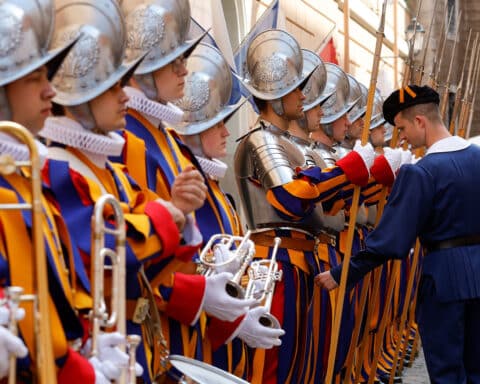VATICAN CITY (CNS) — Pope Francis’ message of hope for humanity will be shot into earth’s orbit as a “nanobook” embedded inside a small satellite and his words will also be transmitted back to earth each day for ham radio reception.
The new space mission, called Spei Satelles, is being promoted by the Dicastery for Communication and coordinated by the Italian Space Agency (ASI). The project was unveiled at the Vatican March 27, the anniversary of Pope Francis’ prayer service he led in an empty St. Peter’s Square at the Vatican in the midst of the coronavirus pandemic in 2020.
Msgr. Lucio Adrián Ruiz, secretary of the Dicastery for Communication, said at the Vatican news conference that they have found many ways to spread the pope’s words and images from that historic evening three years ago: first as a global livestream, then a book “Why Are You Afraid? Have You No Faith?” which gathers together Pope Francis’ most significant speeches and comments during the pandemic.
That book was later turned into a palm-sized edition that went to the North Pole and Norway’s Svalbard Global Seed Vault, the world’s largest seed vault, as a symbol of the safeguarding of the planet’s biodiversity.
While more than 150,000 copies of the book have now been sold around the world, the monsignor said the next step was to send the book literally around the world in a low earth orbit satellite as a symbolic gesture of extending the pope’s loving embrace even farther.
In fact, the Latin name of the mission, Spes Satelles, can be translated as “satellite of hope” and “guardian of hope,” Msgr. Ruiz said, to signify the satellite is also a guardian, keeping the pope’s message of hope alive for all of humanity.
About two dozen students at the Polytechnic University of Turin built the mini satellite called a CubeSat, which will house the nano version of the pope’s book.
The nanobook was created by Italy’s National Research Council (CNR). The lab converted the 150-page book — about 86 square feet of printed material — into binary code that fits on a tiny chip, said Andrea Notargiacomo, head researcher in nanotechnology at CNR. The 2 mm-by-2 mm chip is about the size of the tip of a crayon.
Sabrina Corpino, a mechanical and aerospace engineer and professor who helped the polytechnical university students, said the satellite is set up to send radio signals back to earth.
If all goes as planned after its scheduled launch from Vandenberg Base (VSFB) in California June 10, any amateur radio receiver should be able to pick up its radio signals (437.5 MHz) transmitting papal messages of hope and peace in English, Italian and Spanish.
Like some other space missions, people are invited to submit their name to be put on a chip that will go with the satellite. However, this mission will take it one step further, said Father Luca Peyron, who is head of the Archdiocese of Turin’s apostolate for the digital world.
To get a “boarding pass” into space, people will be asked to carry out a corporal or spiritual work of mercy or non-Catholics can perform a gesture or deed that fosters human fraternity, he said.
This way, the pope’s words will have symbolic significance “up there” in the heavens, he said, and concrete action “down here” on earth.
People can take part by going to speisatelles.org where they can get their virtual boarding pass and follow the mission’s progress. Students and teachers at the Salesian University Institute in Venice created the Spei Satelles logo, which depicts beads of the Rosary circling the earth, which is formed by two “S” letters.
Pope Francis was scheduled to bless the satellite and the nanobook at the end of his general audience May 29.





